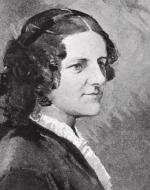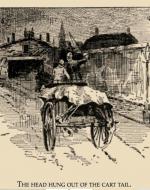Created by Lorelei Heuer on Tue, 10/15/2024 - 11:30
Description:
Anna Sewell's Black Beauty is a beloved story that has been appreciated since 1877 for its timeless significance and empathetic story telling. The novel is from a first person perspective of our horse protagonist, Beauty. It follows his stages of life as he is passed between masters, some cruel and some kind. The qualities of these masters reflect the theme of the children’s novel, which is a lesson to all about the importance of being kind to all of God’s creations. Two years after the release of the novel, one million copies of Black Beauty were in circulation in the United States. Sewell criticizes the use of blinders, checkreins, or the shortening of a horse's tail “for fashion.” The outrage from readers resulted in the checkrein being abolished from Victorian England. Legislations in various states were developed to prevent these abuses and in the Encyclopedia of Animal Rights and Animal Welfare, Bernard Unti calls Black Beauty "the most influential anti-cruelty novel of all time."
Cover of the novel Black Beauty, first edition 1877, published by London: Jarrold and Sons. This original cover is beautifully framed with golden wheat, which alludes to Beauty's first and last homes. This particular book, selling for the price of £35,000.00, is inscribed by Sewell to her cousins, making it especially valuable as Sewell only lived for a few months after her book’s publication. The cover displays Black Beauty in the center, asserting him as the subject of the book. The subtitle of Black Beauty, “His Grooms and Companions, the Autobiography of a Horse,” informs us that the book is written in a memoir style that chronicles the horse’s life experiences, and the former part emphasizes the importance of the impact his masters had on his life. The personification of the animals in the story that are affected by human cruelty creates an emotional connection that develops empathy for animals, helping readers to understand why the mistreatment of animals is wrong. This piece of children’s literature is also the first autobiography from the vantage point of an animal. It acts as a didactic text with Christian influence, reflecting the nature of children’s literature in this time it was written in.
Portrait of Anna Sewell (1820-1878), Wordsworth Editions. The portrait on the second figure is of the author Anna Sewell. Sewell was born in 1820 in Yarmouth, England. At the age of fourteen she broke her ankle, which permanently disabled her and put her in bad health for the entirety of her life. Because of her mobility issues, she relied heavily on horses for transportation, developing her connection with them and opening her eyes to their mistreatment at the hands of cruel owners. Later on her health conditions worsened, and she was bedridden, which motivated her to put her efforts into writing about a Victorian issue she was passionate about: the cruel treatment of horses and disregard for their well-being. Sewell says the purpose of her writing in the novel is "to induce kindness, sympathy, and an understanding treatment of horses." As a Quaker, Sewell appeals to religious morality, as Christianity was the dominant religion of the time, and the novel essentially functions as a didactic text for this reason.
C. Hewitt, “The moon had just risen above the hedge, and by its light I could see Smith lying a few yards beyond me.” In Black Beauty: His Grooms and Companions. The Autobiography of a Horse by Anna Sewell. Translated from the Original Equine. Jarrold and Sons, 1877. First edition. The engraved frontispiece is from C. Hewitt. The illustration depicts a crucial scene in the story which brings forth the discussion of alcohol abuse. A man named Reuban Smith was a very good driver and a pleasant man, “but he had one great fault and that was the love of drink” (Sewell 71). Reuben Smith became careless after drinking and dismissed attending to an issue with Beauty’s shoe, which unfortunately resulted in a terrible accident. The man’s carelessness cost him his life and injured Beauty, so he was forever blemished. The illustration shows the poor horse hanging his head in sorrow for the circumstance, as he looks down upon the drunkard who ruined him.
“The Head Hung Out of the Cart Tail,” Black Beauty, by Anna Sewell, 1877, from Young Folks edition, 1902. This illustration by an unknown artist renders the tragic moment in which Beauty sees his beloved friend Ginger being carried off in cart after dying from overwork and abuse. She has suffered in the past at the hands of cruel owners, and because she is always strained, her position in the structure of occupations for horses kept getting lower down on the ladder, making it more likely for her to be mistreated. Poor Ginger, once feisty, has now been beaten down into hopelessness. The suffering horse laments,“..men are strongest, and if they are cruel and have no feeling, there is nothing that we can do, but just bear it–bear it on and on to the end. I wish the end was come, I wish I was dead” (Sewell 121). And soon she is. The illustration doesn’t sugar coat the death for children and chooses to show the harsh reality of the cruelties that occurred every day. This is in the stylistic nature of didactics, which approach serious subjects with an unsettling directness that was prominent in nineteenth-century children’s literature. The image evokes sadness because it shows the bleak outcome for many horses who endure wickedness.
Movie poster for Black Beauty film adaption written and directed by Caroline Thompson, distributed by Warner Bros. July 29th, 1994. The 1994 adaptation of Black Beauty was directed and written by Caroline Thompson and gave further attention to the issues brought forth in the novel. It visualizes the key scenes, and the beautiful movie poster makes Beauty look heroic and endearing, highlighting her human connection. The retelling of this story through the creation of multiple movie adaptations reinforces the message for modern children in an accessible way. It shows that the novel is truly timeless and stays in the hearts of many. The adaptations of children's literature continues their legacy and preserves their relevancy for modern day children.






